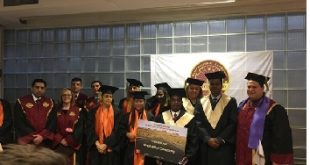As part of the course ‘Conservation and Society’, a group of students from FLAME University took a field trip to the outskirts of the Koyna Wildlife Sanctuary on April 1, 2023. The objective was to observe the implementation of community-based conservation. The Wildlife Research and Conservation Society (WRCS) has been running a community-based conservation program in the Koyna-Chandoli corridor for the last ten years. Three members of the team, Mr. Sunil Kale, Mr. Balkrushna Bhomkar, and Mr. Vinod Kamble walked us through their program, objectives, initiatives, plantations, and the communities they work with. But what is community-based conservation? Essentially, community-based conservation is an approach to conservation wherein local communities actively participate in conservation practices to the maximum degree possible. The advantage is two-fold – environmental protection and socio-economic development of local communities.
Education is an important determinant of community development, one that has profound effects on all aspects of life; social, economic, professional, and environmental. It influences how we think, how we navigate through society, and how we interact with the natural world. Education is instrumental in building a better future. Environmental education and social upliftment through education are, therefore, a key elements of community-based conservation. Keeping this in mind, students visited the Zila Parishad Primary School in the village of Vanzole, one of the villages that have engaged in community-based conservation in collaboration with WRCS. WRCS works to teach the students at this school about the need for environmental protection, conservation practices, and sustainable development. The organization works to imbibe a sense of value and responsibility for the environment in young children.
Additionally, WRCS strives to provide resources needed to educate the children of Vanzole. Recently, the team donated a personal computer to the school, provided by their funding agency. Not only is this a teaching aid, but it also gives students the opportunity to learn basic computer skills.
Zila Parishad Primary School, Vanzole, is a government-run Marathi-medium school. Presently, a total of twenty students from grades I to V are receiving their primary education here. this school severely lacks funding and resources. Despite this, the school has two excellent teachers who teach their students with passion and patience, Mr. Anil Zohre (also headmaster of the school) and Mr. Pandurang Sawant, who work tirelessly to ensure that each student receives the attention and guidance they require to succeed in their academics. They teach Math, English, Science, Geography, Arts and Crafts. Since there are only two classrooms and two teachers, the teachers attend to students from different grades simultaneously. While one group of students is being taught, the rest of the students are made to do worksheets and practice questions. However, Math and English are taught together to all students by Mr. Zohre.
In conversation with Mr. Zohre, he mentioned that he had designed worksheets and teaching aids for students who struggle with dyslexia and dyscalculia at the previous school he worked at. He brought these resources with him to Vanzole to help students who may be struggling with learning disabilities. He is also striving to remove the fear attached to learning and speaking the English language. Drawing from his own experiences, Mr. Zohre expressed how it is a struggle to shift from schools where the medium of instruction is Marathi to colleges where everything is taught in English. Most children can’t practice the language as nobody at home speaks it. As they grow up, they hesitate to speak for fear of being incorrect or judged. Mr. Zohre works to help his students become confident learners and speakers of the language.
With the objective of teaching responsibility, conservation, and sustainability, the school started growing a kitchen garden. All the students work together to look after the garden. This is a lovely example of how conservation practices bring people together. They are growing spinach, tomatoes, cabbage, and chilies, all of which are being incorporated into their midday meals. This also helps attenuate the financial stress of providing midday meals to the children. The students are proud of their garden, diligently do their part, and beam with excitement when the plants bear vegetables.
Despite language barriers, conversations, activities, and games with the children revealed that they are bright, hardworking, and curious. While interacting with us, we noticed that they could comprehend some of what we were saying in Hindi, and tried their best to communicate with us. Each student has a file – a compilation of their best work, ranging from essays and worksheets to drawings and craftwork. Although the children are close-knit, one can see their individuality shine through their work, their interests, and the little accessories they wore along with their uniform.
With the backing of the community through the gram panchayat, the school’s management has begun improving the infrastructure of the school. Soon, they plan to build handwashing stations, and drinking water dispensers, install smart boards, and create a lawn for children to play in.
Although things are improving, the community still faces some pressing challenges. Firstly, during the COVID-19 pandemic, the school was closed for two years, during which many students dropped out. Secondly, many people from the village migrate to cities like Pune and Mumbai in search of more lucrative jobs and take their children along with them. Some spend a few months in the city and come back to the village for the harvest season. As Mr. Kale explained, this lack of stability compromises the education of the children. Children have to change schools often, or just end up dropping out of school. The solution to this problem? Well, one possible solution is to create more employment opportunities in the community. WRCS employs locals to work on their plantations based on a daily-wage system. While this is a step in the right direction, it is not enough to keep people from emigrating.
Overall, community-based conservation in this region seems promising, with visible benefits to both the environment and the community. The people of Vanzole have compassion for the environment and WRCS and the school have done a good job at imbibing that sensitivity in children at a very young age. This gives us hope for the future of our people and our environment.
by Shaina Boparai, Grisha Chopra, and Ananya Tekriwal
 Newspatrolling.com News cum Content Syndication Portal Online
Newspatrolling.com News cum Content Syndication Portal Online




